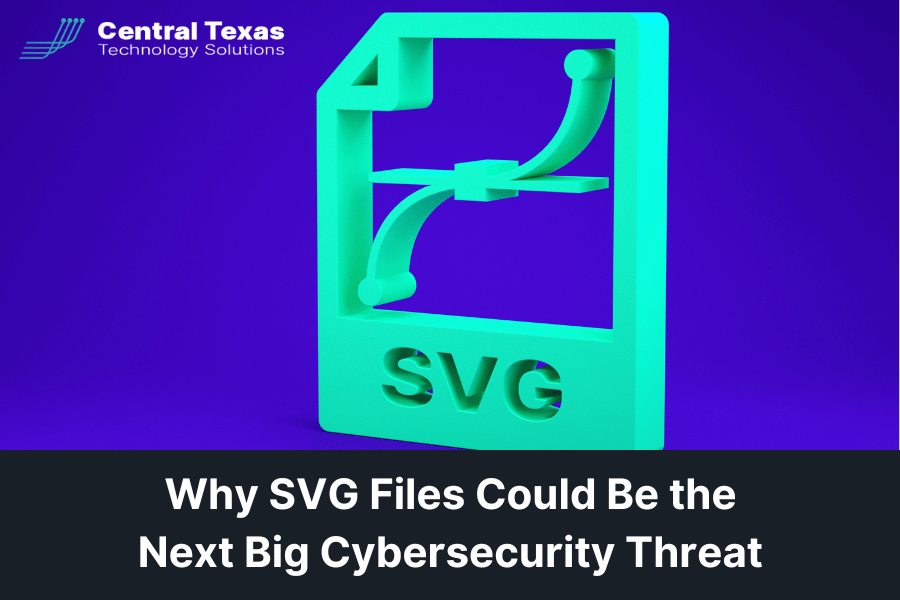
Cybercriminals Are Exploiting a Surprising Cybersecurity Threat
Hackers never stop finding new ways to steal business data, and their latest weapon of choice may surprise you. SVG files, commonly used for logos, icons, and scalable web graphics, are now being leveraged for phishing attacks. Because these files aren’t typically flagged as malicious, they can easily slip past security filters, making them a powerful tool for cybercriminals.
One of the most alarming uses of SVG-based phishing is tricking users into handing over their Office 365 login credentials. With just a single click, attackers can gain access to sensitive business accounts, leading to devastating data breaches. If your business isn’t already on high alert for this emerging cybersecurity threat, now is the time to take action.
How Hackers Turn SVG Files Into a Cybersecurity Threat
Most people associate phishing attacks with suspicious links and fake email attachments, but SVG files introduce a new challenge. Unlike traditional image formats, SVG files are coded in XML, meaning they can contain scripts that execute malicious commands.
Here’s how cybercriminals use SVG files in phishing attacks:
- Step 1: Fake Email Delivery – An attacker sends an email containing an SVG file, often disguised as an invoice, document, or company communication.
- Step 2: Hidden Code Activation – If the recipient opens the SVG file in a web browser, hidden JavaScript code executes in the background.
- Step 3: Phishing Page Deployment – The file redirects the user to a fake login page, often mimicking Office 365 or another familiar platform.
- Step 4: Credential Theft – Unsuspecting users enter their login credentials, which are instantly sent to the attacker.
Because SVG files are not typically associated with malware, many email security systems fail to detect them as threats. This makes them an increasingly popular tool for cybercriminals looking to bypass even the most advanced security defenses.
How to Protect Your Business from SVG-Based Phishing Attacks
Awareness is the first step in defending against new cybersecurity threats. Here are three essential steps to protect your business from SVG phishing attacks:
1. Educate Your Employees on SVG Phishing Risks
- Train your team to recognize the risks associated with SVG files.
- Encourage employees to avoid opening attachments from unknown senders.
- Reinforce that SVG files are primarily used for web design and should be handled with caution.
2. Restrict SVG File Handling on Company Devices
If employees don’t need to open SVG files for work, configure company devices to prevent browsers from launching them. A simple way to do this is to set SVG files to open in a text editor instead of a browser:
- Right-click a safe SVG file on a Windows computer.
- Choose "Open With" and select Notepad.
- Check the box to always open SVG files with Notepad.
This ensures that SVG files are displayed as raw text rather than executing scripts, reducing the risk of phishing attacks.
3. Strengthen Email Security Against Emerging Threats
- Ensure your email security software is updated to detect and block SVG-based phishing attempts.
- Implement advanced threat protection (ATP) features that analyze attachments for malicious behavior.
- Use multi-factor authentication (MFA) to prevent unauthorized access, even if credentials are compromised.
Stay Ahead of Emerging Cybersecurity Threats
Cybercriminals are constantly evolving their tactics, and SVG phishing attacks are just one example of how they bypass traditional security measures. Staying informed about these threats and implementing proactive defenses will help keep your business safe from the next wave of cyberattacks.
By educating employees, restricting SVG file execution, and reinforcing email security, you can significantly reduce the risk of falling victim to this new cybersecurity threat.
FAQ About Protecting Your Business from SVG Phishing Attacks
1. Are SVG files always dangerous?
No, SVG files themselves are not inherently harmful. The risk comes from SVG files that contain embedded scripts designed for phishing attacks. If your business regularly uses SVG files for design purposes, ensure they come from trusted sources.
2. How can I tell if an SVG file is malicious?
It’s difficult to visually detect a malicious SVG file. The best defense is to avoid opening unknown SVG files, use security software to scan email attachments, and configure SVG files to open in a text editor rather than a browser.
3. What should I do if I suspect an SVG phishing attack?
If you or an employee accidentally opens a suspicious SVG file, immediately change any compromised passwords and enable multi-factor authentication. Report the incident to your IT team or cybersecurity provider to assess potential risks and prevent further damage.
Contact CTTS today for IT support and managed services in Austin, TX. Let us handle your IT so you can focus on growing your business. Visit CTTSonline.com or call us at (512) 388-5559 to get started!
